Abstract
In the present work, some investigations have been carried out on hot tears in the Al–1 wt.% Sn alloy, with the objective of preventing hot tearing in aluminum castings. Al–1Sn alloy is extremely prone to hot tearing due to its long freezing range and is an ideal model for studying hot tearing. Experiments were conducted with varying grain refiner (Al–5Ti–1B) percent and pouring temperature. Grain refiner was added to the melt up to 3.0% by weight, which is the conventional limit for grain refiner addition. However, it was found that the maximum addition of grain refiner could not prevent hot tearing, which contradicts the conclusions of some earlier researchers. A mathematical model developed from the experimental data (using regression analysis) has indicated that, among all the constituents present in the Al–1Sn alloy, tin highly increases hot tearing tendency, whereas titanium in the grain refiner decreases hot tearing tendency. The model has also indicated that iron, which is the common impurity in commercial aluminum, reduces hot tearing. Based on the aforesaid model, further experiments were conducted with the addition of iron, which has resulted in complete elimination of hot tearing. Microstructural analysis was carried out using a scanning electron microscope (SEM). The leaf-like structure containing the Al–Sn–Fe-rich phase held the adjacent grains together and thus prevented hot tearing.
Similar content being viewed by others
References
Dodd RA (1956) Hot tearing of castings—A review of the literature. Foundry Trade J 101:321–331
Davies Vde L (1970) The influence of grain size on hot tearing. Br Foundrym 43:93–101
Lancaster JF (1993) Metallurgy of welding, 5th edn. Chapman & Hall, London, pp 303–307
Wyman CH, Faist CA, Sylvestro GD (1952) Investigation of hot tears in steel castings, Part-3 Hot tear investigation. AFS Trans 60:145–162
Eeghem JV, Sy AD (1965) A contribution to understanding the mechanism of hot tearing of cast steel. AFS Trans 73:282–291
Metz SA, Flemings MC (1969) Hot tearing in cast metals. AFS Trans 77:329–334
Schmid F (1965) Elimination of hot tear cracking in castings. AFS Trans 72:462–466
Chojecki A, Telejko I, Bogacz T (1997) Influence of chemical composition on the hot tearing formation of cast steel. Theor Appl Fract Mech 27:99–105. doi:10.1016/S0167-8442(97)89529-8
Rappaz M, Rettenmayr M (1998) Simulation of solidification. Curr Opin Solid State Mater Sci 3(3):275–282. doi:10.1016/S1359-0286(98)80103-4
Maile K, Theofel H, Weichert C, Mayer KH, Gerdes C, Sheng S (2001) Assessment of hot tears in cast steel components. Int J Press Vessel. Pip 78(11):865–874
Zhang J (2003) Effect of Ti, Ta on hot cracking susceptibility of directionally solidified Ni-based super alloy IN792. Scr Mater 48:677–681. doi:10.1016/S1359-6462(02)00559-6
Sigworth GK, Guzowski MM (1985) Grain refining of hypoeutectic Al–Si alloys. AFS Trans 93:907–912
Easton M, St. John D (1999) Grain refinement of aluminum alloys: Part II. Confirmation of a mechanism for the solute paradigm. Metall Mater Trans A 30A:1625–1633. doi:10.1007/s11661-999-0099-4
Boot D, Cooper P (2002) A comparison of grain refiner master alloys for the foundry. In: TMS 2002, Proc 131st Annu Meet & Exhib, Seattle, 17–21 February 2002
Fabrègue D, Deschamps A, Suéry M (2004) A study of hot tearing in aluminium alloys in relation to laser welding: Mechanical behaviour in the mushy state during non-isothermal tensile testing with high cooling rates. Mater Forum 28:1–7
Monroe C, Beckermann C (2005) Development of a hot tear indicator for steel castings. Mater Sci Eng A 413:30–36. doi:10.1016/j.msea.2005.09.047
Cao G, Kou S (2006) Hot tearing of ternary Mg–Al–Ca alloy castings. Metall Mater Trans A 37(12):3647–3663. doi:10.1007/s11661-006-1059-x
Nagaumi H, Suzuki S, Okane T, Umeda T (2006) Effect of iron content on hot tearing of high-strength Al–Mg–Si alloy. Mater Trans 47(11):2821–2827. doi:10.2320/matertrans.47.2821
Pierer R, Bernhard C, Chimani C (2007) A contribution to hot tearing in the continuous casting process. Rev Metall 2:72–83
Zhou YZ, Volek A (2007) Effect of dendrite arm spacing on castability of a directionally solidified nickel alloy. Scr Mater 56(6):537–540. doi:10.1016/j.scriptamat.2006.11.002
Hatami N, Babaei R, Dadashzadeh M, Davami P (2008) Modeling of hot tearing formation during solidification. J Mater Process Technol 205:506–513. doi:10.1016/j.jmatprotec.2007.11.260
Zhou Y, Volek A (2008) Effect of carbon additions on hot tearing of a second generation nickel-base superalloy. Mater Sci Eng A 479:324–332. doi:10.1016/j.msea.2007.06.076
Massalski TB (1990) Binary alloy phase diagrams, Second edition. ASM Int 1(148):183–216
Author information
Authors and Affiliations
Corresponding author
Rights and permissions
About this article
Cite this article
Benny Karunakar, D., Naresh Rai, R., Patra, S. et al. Effects of grain refinement and residual elements on hot tearing in aluminum castings. Int J Adv Manuf Technol 45, 851–858 (2009). https://doi.org/10.1007/s00170-009-2037-4
Received:
Accepted:
Published:
Issue Date:
DOI: https://doi.org/10.1007/s00170-009-2037-4




